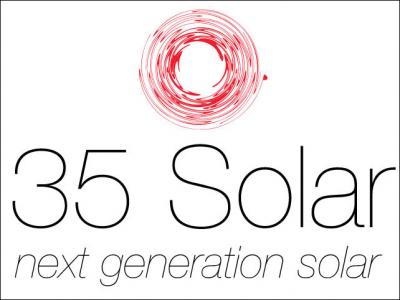Revolutionary solar energy technology turns to Kickstarter to help fund launch

What if we could produce solar power more cheaply than coal power? It sounds too good to be true, of course. But a pair of entrepreneurs at New Mexico State University's Arrowhead Center have an idea that could revolutionize the way solar panels are made, cutting costs enough to make solar power a real competitor in the energy market - they just need a chance to prove that it works.
To lure investors, you need a working prototype - and to develop a working prototype, you need investors. So the entrepreneurs - Kramer Winingham and Leon Viveros - are looking to a relatively new method of funding their prototype project: Kickstarter. Launched in 2009, Kickstarter.com is a website where entrepreneurs, artists, filmmakers - anyone with a creative idea - can connect with backers who have an interest in funding the project.
Winingham and Viveros have given themselves until Aug. 17 to raise $14,995 toward creating the project. Since the project, titled 35 Solar, launched on the Kickstarter site on July 9, they've raised more than 10 percent of their goal. They're hoping that a growing interest in sustainable energy will drive investors to their site, http://www.kickstarter.com/projects/1765055281/35-solar-next-generation-photovoltaics, to learn more about the new technology and make a contribution.
Solar panels collect energy from the sun using thin film - sheets of conductive material only nanometers thick. The films are layered between panels of glass to create each solar cell. The reason that solar power struggles to compete in the energy market, with only about 1 percent of renewable energy coming from solar, is that the panels are very expensive to create. The thin films must be manufactured in an extremely controlled vacuum environment to ensure they achieve the uniformity of thickness and purity of materials necessary to create power with any efficiency.
In short, the panels must be perfect, or it's not worth the cost to make them. And to lower the cost per watt to produce electricity from the sun, you've either got to raise the efficiency significantly or greatly lower the production cost.
"It's about the cost," Winingham said. "Everything else is limited by how expensive it is to produce."
Winingham and Viveros both work at the Arrowhead Center helping student startups and commercializing NMSU and regional technologies. Winingham was working last summer on a partnership with Los Alamos National Laboratory to evaluate technologies developed there and assess their potential commercial applications. In the lab's portfolio of technologies, he came across something that caught his eye: polymer-assisted deposition, or PAD, a recently developed method for depositing molecules using a chemical solution that could be applied to create coatings and thin films without the need for an expensive and inefficient vacuum environment.
The method is already being used to create thin-film batteries and other nanomaterials with success. Winingham and Viveros - who both have experience in renewable energy development - see an opportunity to use this more-efficient method to create thin films for solar panels, which they estimate would cut the capital cost of panel manufacturing facilities by 75 percent.
"They sound like a science fiction novel, but they're technologies that we can use now," Viveros said. "Finally, we're seeing things happening that were promised to us when solar technology was first developed."
They're working with NMSU chemical engineering assistant professor Hongmei Luo, who is the principal investigator of the Thin Films and Nanomaterials Research Group on campus.
"Polymer-assisted deposition is a cost-effective powerful chemical solution method to deposit films of a variety of materials, such as metals, semiconductors, oxides, nitrides and carbides," Luo explained. "PAD is a solution method and therefore scalable with little increase in cost. This method does not require high vacuum and therefore it does not have high capital costs."
PAD would replace another method, chemical vapor deposition, which requires the vacuum environment, but would use the same panel designs, resulting in similarly efficient panels at a fraction of the cost.
Two graduate students in the lab, Gen Chen and Yuling Li, are working to develop a prototype solar cell using the technology. Since they're already using the PAD method for other purposes, the lab has all the equipment needed to make and test the prototype. The money raised through the Kickstarter campaign will be used to pay for their work. Eventually, the 35 Solar team wants to test out PAD on each type of solar cell on the market.
In addition to its potential for cost savings, PAD provides another advantage: while current methods of solar cell production necessitate flat cells that must be carefully positioned at an angle that affords maximum efficiency, a lower cost thin film could be applied to irregular surfaces - like a cell phone or a car's roof - or placed on south-facing building windows where a traditional panel wouldn't be cost-effective enough.
Winingham said 35 Solar is uniquely positioned to take advantage of the resources nearby, introducing technology from LANL to chemical engineering experts at NMSU.
"The resources in New Mexico are just tremendous," he said. "It's all about connecting those resources to each other."
Arrowhead Center Chief Operating Officer Kathryn Hansen said it's always a thrill to see what happens when those connections yield innovations with the potential to revolutionize an industry.
"We are so excited about the potential for 35 Solar, and the drive of Kramer and Leon to make a successful business using this futuristic technology," Hansen said.
Arrowhead's commercialization efforts are supported by an i6 Challenge grant funded by the U.S. Department of Commerce's Economic Development Administration.
To contribute to the Kickstarter campaign, visit http://www.kickstarter.com/projects/1765055281/35-solar-next-generation-photovoltaics. For more information about 35 Solar, visit www.35-solar.com. To learn more about Arrowhead Center, visit arrowheadcenter.nmsu.edu.


